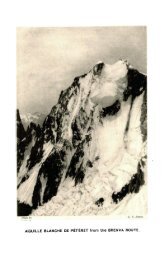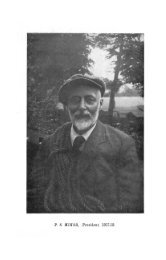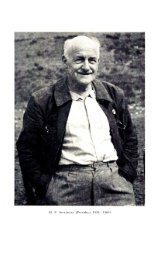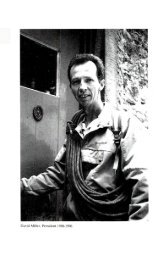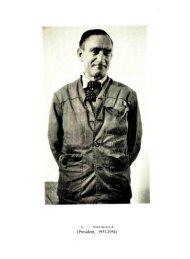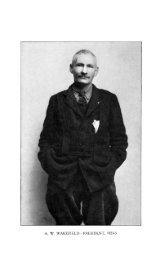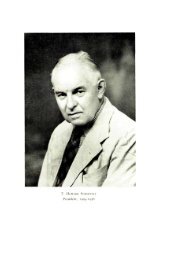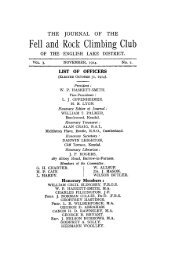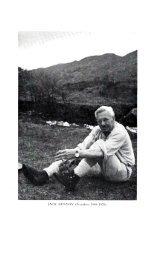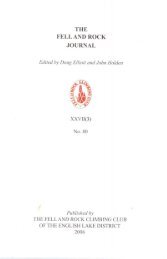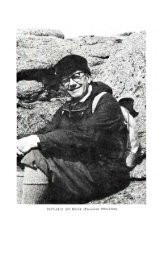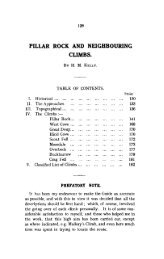Number in series 70; Year of publication 1986 - Fell and Rock ...
Number in series 70; Year of publication 1986 - Fell and Rock ...
Number in series 70; Year of publication 1986 - Fell and Rock ...
Create successful ePaper yourself
Turn your PDF publications into a flip-book with our unique Google optimized e-Paper software.
John Wilk<strong>in</strong>son 53are now Hard Very Severe (Deer Bield Crack 4c, Kneewrecker Chimney 5a,Perhaps Not 5a, Gimmer Girdle 5a, Grooves Superdirect 5b), with Kipl<strong>in</strong>gGroove 5a, as the hardest climb: Do Not, the second hardest climb <strong>in</strong> the list, isnow graded El 5b. Do Not would appear to be the first El <strong>in</strong> the Lakes, s<strong>in</strong>ceHarlot Face (1949), which was an Extreme <strong>in</strong> the 1969 edition <strong>of</strong> the Eastern<strong>Fell</strong>s guide, has now been downgraded to HVS <strong>in</strong> the 1979 edition. It is clear,however, that by the end <strong>of</strong> the 1940's there were a number <strong>of</strong> routes on theborderl<strong>in</strong>e <strong>of</strong> HVS/E1, with pitches <strong>of</strong> 5a <strong>and</strong> 5b.It is, perhaps, an overgeneralization to suggest that <strong>in</strong>creased climb<strong>in</strong>gst<strong>and</strong>ards were solely due to improvements <strong>in</strong> equipment <strong>and</strong> technique.Tra<strong>in</strong><strong>in</strong>g <strong>and</strong> attitude <strong>of</strong> m<strong>in</strong>d were also <strong>of</strong> great importance, <strong>and</strong> there havealways been a few exceptional climbers around to whom lack <strong>of</strong> protection orthe use <strong>of</strong> rudimentary equipment made little or no difference to their highst<strong>and</strong>ard <strong>of</strong> performance. Indeed, from the earliest days <strong>of</strong> the sport whenHaskett Smith set a precedent with his solo first ascent <strong>of</strong> the Needle, there havealways been a few bold <strong>in</strong>dividuals who were prepared to solo some <strong>of</strong> thehardest climbs <strong>of</strong> the day, although there is no record <strong>of</strong> a solo first ascent <strong>of</strong> ahard route dur<strong>in</strong>g this period, <strong>and</strong> even today such solo ascents are uncommon.Ronnie Jackson on his fleet<strong>in</strong>g trips to the Lakes <strong>in</strong> the late 1930's was solo<strong>in</strong>g,<strong>in</strong> nails, routes such as Elim<strong>in</strong>ate 'B', Great Central Route, <strong>and</strong> Black Wall, allcurrently graded HVS: <strong>and</strong> <strong>in</strong> the mid 1940's Joe Griff<strong>in</strong> began a programme <strong>of</strong>solo<strong>in</strong>g hard routes which has cont<strong>in</strong>ued virtually un<strong>in</strong>terrupted for (so far)forty years. Also many climbs were led virtually without protection, <strong>and</strong> to all<strong>in</strong>tents <strong>and</strong> purposes constituted solo ascents: for example Ken Heaton'srunnerless lead <strong>of</strong> the first pitch <strong>of</strong> Do Not.Of the eleven hard (HVS <strong>and</strong> El) climbs put up dur<strong>in</strong>g this period, <strong>of</strong> whichsix were <strong>in</strong> Langdale <strong>and</strong> were climbed <strong>in</strong> 1948 <strong>and</strong> 1949, n<strong>in</strong>e were climbed byeither Birkett or Dolph<strong>in</strong>, the honours be<strong>in</strong>g almost equally shared.The 1950's — A Climb<strong>in</strong>g ExplosionThe austerity <strong>of</strong> the war years was fast becom<strong>in</strong>g an unpleasant memory, <strong>and</strong>large numbers <strong>of</strong> people were tak<strong>in</strong>g to the hills at weekends <strong>and</strong> holidaysma<strong>in</strong>ly as a result <strong>of</strong> a more affluent <strong>and</strong> car-own<strong>in</strong>g society. There were moreclimbers than ever before, <strong>and</strong> more <strong>of</strong> them were climb<strong>in</strong>g hard routes. Whilstthe exploration <strong>of</strong> the 1940's was ma<strong>in</strong>ly <strong>in</strong> the h<strong>and</strong>s <strong>of</strong> four men, well over adozen participated <strong>in</strong> the discovery <strong>of</strong> new routes <strong>in</strong> the follow<strong>in</strong>g decade.Perhaps the most surpris<strong>in</strong>g feature <strong>of</strong> the 1950's was that whole areas <strong>of</strong> theLakes were still neglected <strong>and</strong> even several <strong>of</strong> the major crags received scantattention. Whilst Langdale, Borrowdale, the Eastern <strong>Fell</strong>s <strong>and</strong> Scafell were allextensively explored, <strong>in</strong> Buttermere <strong>and</strong> Newl<strong>and</strong>s, the scene <strong>of</strong> such franticactivity <strong>in</strong> the 1940's, there appeared little enthusiasm for new routes afterPeascod's departure for Australia: Dow was left severely alone, <strong>and</strong> it was the223



